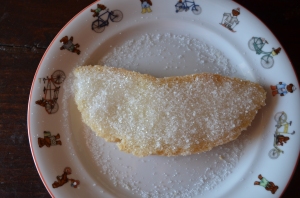In order to instill a lifetime of sound eating habits in your children, all you need is an Italian grandmother, and the will to stand back for twelve years or so, while she feeds them the opposite of what you would. You won’t have to foist the responsibility on her—she will take it as soon as she can. Conversely, should you not care to hand it over, you’ll find her expert slavish service to your child will remove your entire generation from the running.
 The moment I gave up nursing, my mother-in-law, Rita, stepped in with a diet of bottles of baby biscuits dissolved in boiled cow’s milk that continued (in its later stages by stealth) until Giorgia was almost five. Starting around six months old, my daughter also got a raw farmer’s egg to drink mid-morning, which quickly became a favorite. (Even the Italian physician balked at this: better a store-bought egg, she said.) At a year or so of age, she was ushered into the three-meals-and-two-snacks day that accompany Italians from the cradle to the grave.
The moment I gave up nursing, my mother-in-law, Rita, stepped in with a diet of bottles of baby biscuits dissolved in boiled cow’s milk that continued (in its later stages by stealth) until Giorgia was almost five. Starting around six months old, my daughter also got a raw farmer’s egg to drink mid-morning, which quickly became a favorite. (Even the Italian physician balked at this: better a store-bought egg, she said.) At a year or so of age, she was ushered into the three-meals-and-two-snacks day that accompany Italians from the cradle to the grave.
Breakfast for children is a bowl of warm milk or orzo (an instant, coffee-flavored, non-caffeinated drink made from barley) into which dry cookies are dunked. (Yogurt, for some reason, is highly suspect and boxed cereal is considered junk food.) Lunch, always on the stroke of one, is a three-course meal at a properly set table: the primo is pasta, of course—the grannies loyal to spaghetti and linguini despite a younger generation increasingly opting for the more manageable pasta corta—with two possible sauces, pomodoro or what the Tuscans just call sugo (“sauce”) and which we know as ragù. The secondo might be a breaded, fried beef cutlet, a slice of arista (pork roast) or a baked chicken, of which the smallest child gets the leg, the ossina (“little bone”) to gnaw on. The contorni, or side dishes are fried potatoes or potato croquettes, and green salad or peas stewed with bits of prosciutto and plenty of oil and salt, which Italian children–like children the world over–avoid. Needless to say, serving a sandwich would be akin to child abuse.

Plenty of tasteless Tuscan bread is sliced and passed around, in case the meal isn’t starchy enough for you, and often it’s served fried (the delicious pane fritto), since there’s some unwritten rule about everything on a plate needing to be roasted or fried or boiled but not cooked by a combination of methods.
Grandmothers here are sticklers for snacks, so at around 5pm out comes the bread again with various toppings: a slice of prosciutto, a smear of raw sausage, drizzles of olive oil (the classic fett’unta or “greasy slice”), and my older daughter’s favorite, a poor man’s sweet indeed: a slice of bread soaked in water and sprinkled generously with sugar to be eaten with a spoon.

Dinner, always and forever at 8 o’clock on the nose, is a repeat of lunch, with a lighter first course, often minestra, tiny beads of pasta boiled in homemade chicken broth. As soon as a child can hold a glass, he starts to drink water, and as soon as he starts to drink water, in go a few drops of wine. “You have to get them used to it,” I’m told. Dessert is often formaggino, a soft, white cheese, spread, you guessed it, on bread, a food stuff in which Italians born before the war place an enormous value. Bread is sostanza, it’s sano (which means “healthy” but also “sane”) and wholesome and pure.

With the exception of the wine, the schools continue in this vein. In elementary school, the children eat lunch with their teachers at little rectangular tables, at each of which one child is appointed to oversee the manners of the others. (You can imagine the fun.) The kitchen staff comes around and serves the first and then second courses, and when the table has finished, the children are excused to go out and play in the schoolyard. Through high school meals hardly change. The dining room of my daughter’s (public) school in Florence happens to be an enormous frescoed salon, with gilded chandeliers. The tables are oval now, and the teachers certainly do not partake, but the staff still comes around with platters of pasta, then meat and contorni, and the students help themselves, eating, chatting and then fleeing through the French doors into the garden beyond.
What proof do I have that’s Rita’s system worked? Only that my children gravitate to three meals a day, at the table all together, and two fortifying snacks, as a kind of scaffolding on which to hang their day-to-day lives. So what was my mother-in-law’s secret to passing on, through meals, a sense of security and ease? I suspect it has nothing to do with food, and everything to do with her availability for the children, the effort and attention to detail and joy she put into all aspects of their care–the vitality in everything she did (and still does).
For a lifetime of pleasurable, balanced eating, I highly recommend this approach. If you can’t find an Italian grandmother, you can trying doing it yourself: Rita prepares the meals between 5 and 6 a.m., and goes to the market at 7:30 each morning, for freshly baked bread.
Jem-
Your best yet. We’re now searching for an Italian grandmother to adopt us.
Bob and Vicki
LikeLike